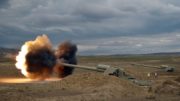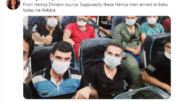Many people know who provides the Armenian occupants with weapons and ammunition. But who exactly helped Armenia create an echeloned system of sabotage bunkers and tunnels on the Azerbaijani lands that it occupied?
Today, martial law is introduced on the front line in Nagorno-Karabakh. In particular, censorship keeps under strict control the dissemination of any information related to the depth of the advance of troops, the battle tactics in mountainous areas, the effectiveness and radius of rocket and artillery shelling, etc.
But in the era of the Internet, it is not so easy to create an information vacuum around a certain event by surrounding it with a wall of silence. Especially when it comes to a full-scale war in the Caucasus, which the world’s leading media have been closely following.
This, in fact, is confirmed by publications appearing from time to time in the media, which give the ordinary reader the opportunity to independently separate the grains of reality from the propaganda chaff in order to understand the patterns and contradictions of the second Karabakh war.
Recently, the website of the Al-Sharq newspaper, which is close to Lebanese parliamentary circles, published a very curious material about an extensive system of underground bunkers and tunnels that Armenia secretly built in the occupied Azerbaijani territories and is currently actively using in the war against the Azerbaijani army.
Citing the opinion of an unnamed Israeli officer of the reserve service (the publication names him as Lieutenant Colonel S.), the author of the publication claims that there are concrete bunkers built at a depth of up to forty meters, in which Armenian units are deployed, capable, due to supplies of food, fuel and ammunition, fight autonomously. In fact, these are multi-level complexes of defensive and offensive facilities, in which the bunkers are interconnected by an extensive network of underground tunnels, provided with control and electronic communication channels, and also protected from enemy counterattacks by anti-tank and anti-personnel minefields.
However, the most curious thing is that, according to S., who was directly involved in the combat operations of the Israeli army on the territory of South Lebanon, engineering and technical characteristics and specifics of the Armenian system of bunkers and tunnels are practically not different from similar defensive structures that are a kind of a “trademark” of the Shiite organization “Hezbollah”.
“It is their highest engineering achievement, a sort of ‘know-how’ in the XXI century fortification, – says S. – “Hezbollah sanctuaries – which is what we in Israel call the fortified areas with bunkers and tunnels of the Lebanese Shiites, became one of the main reasons for the failure of the ground forces of the IDF in the 2006 war. As a result, Sheikh Nasrallah’s military experts and engineers are now using this “bunker” technology far beyond the Israeli-Lebanese border. Exactly the same tunnels were dug between Lebanon and Syria (in the Bekaa valley, the area of Kalamoun and Al-Qusayrah mountain range), in the north of Yemen, in Al-Hudeid, from where the Houthis make armed sorties into the territory of Saudi Arabia, and finally, in Beirut itself, where Hezbollah dug and equipped an extensive network of underground structures in the immediate vicinity of the Hariri International Airport and under the football field of the municipal stadium…”
“Why are you so sure that the bunkers in Armenia are certainly the creation of Hezbollah? – asked the journalist of “Al-Sharq”. – It is quite possible that my fellow countrymen, the Lebanese Armenians, are skilled in this matter. As far as I know, many of them, before repatriation to Armenia, where they settle mainly in Nagorno-Karabakh, had close contacts with the Shiites and were even members of Hezbollah…”
(As a short commentary, I would like to note that the question is quite relevant, given that today there are about one hundred and fifty thousand Armenians living in Lebanon, which has a population of six million, and also function an Armenian Haygazyan University, about thirty elementary and secondary educational national schools, three daily newspapers, two around the clock broadcast radio stations… (A.K.)
“Even if we assume that representatives of the Armenian community are a part of the leadership of the Lebanese Shiite organization,” replies Lt. Col. S., the locations and technology of “Hezbollah sanctuaries” are kept under such lock and key that even members of the top leadership of this structure do not have full information. In short: I do not have a slightest doubt that underground complexes were built in Armenia by using technology and under the technical control of the Lebanese. It is only unclear whether the leadership of Armenia connected with Hasan Nasrallah via personal links, or whether the contact was established through the mediation of Iran …”
The publication in Al Sharq is very important. Mainly because it sheds light on a number of fundamental political issues, on which the leaders of the world community to this day do not have a united view.
First of all, it becomes obvious that in recent times, not only Azerbaijan armed itself and prepared for war, with the aim of returning its own territories should peacekeeping efforts fail, but also Armenia, which declared in words its readiness to solve the Nagorno-Karabakh problem at the negotiating table, but in reality was building its own Armenian “Maginot Line” on the sovereign territories of Azerbaijan.
It is also clear that an endless series of peace initiatives and negotiations involving the representatives of the United States, Russia, France, the European Union, the OSCE, etc. as authoritative arbitrators, was cynically used by Armenian diplomacy as a smokescreen, behind which the leaders of the Republic of Armenia and the self-proclaimed “Artsakh” were prolonging time in every possible way, trying to freeze indefinitely the “status quo” and thus “appropriate” the sovereign territory of the Republic of Azerbaijan…
Well, the second Karabakh war, which the entire Azerbaijani people rightfully calls liberation war, will certainly go down in history as an event that dotted the i’s and finally tore the masks of civilized peacemakers and fighters for justice from the leaders of Armenia and the Armenian diasporas, behind which, as it turns out, there is not even a hint of civility – only sheer ambitions, sophisticated hypocrisy and lies, endless lies …
An occupant country, which is willing to comply with the UN resolutions and withdraw from the occupied territory, will not build on it fortifications, surrounded by minefields.
Otherwise, it will be incriminated in preparation for a sabotage war against a neighboring state. And with such a “diagnosis” it is not really appropriate to appeal to the world community with calls to recognize a nation’s right to self-determination.
An occupant country, ready to comply with the UN resolution and withdraw from the occupied territory, will not resort to the services of hundreds and thousands of militants from the terrorist organizations of Syria and Iraq, with the help of which it is trying to continue resistance in order to hold onto the occupied territories.
Otherwise, it will get a sad reputation of a rogue country, which even the propaganda divisions and battalions of the Armenian diaspora will not be able to clean.
An occupant country, ready to comply with the UN resolution and leave the occupied territory, strives to save the lives of its compatriots, and not to throw old people, women and children into the meat grinder of a lost war. Otherwise, the world community (without any interference from Turkey) can officially charge the Supreme Commander-in-Chief of Armenia Nikol Pashinyan with genocide of his own people.
And then the Prime Minister of Armenia, who has not proven himself in any way in the past and has disgraced himself on all counts in the present, will face a truly worthy future – a trial in the Hague International Tribunal…
By Valery Kantor




Be the first to comment at "In the labyrinths of underground Karabakh"